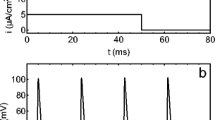Abstract.
The Hodgkin–Huxley equations with a slight modification are investigated, in which the inactivation process (h) of sodium channels or the activation process of potassium channels (n) is slowed down. We show that the equations produce a variety of action potential waveforms ranging from a plateau potential, such as in heart muscle cells, to chaotic bursting firings. When h is slowed down – differently from the case of n variable being slow – chaotic bursting oscillations are observed for a wide range of parameter values although both variables cause a decrease in the membrane potential. The underlying nonlinear dynamics of various action potentials are analyzed using bifurcation theory and a so-called slow–fast decomposition analysis. It is shown that a simple topological property of the equilibrium curves of slow and fast subsystems is essential to the production of chaotic oscillations, and this is the cause of the large difference in global firing characteristics between the h-slow and n-slow cases.
Similar content being viewed by others
Author information
Authors and Affiliations
Additional information
Received: 9 August 2000 / Accepted in revised form: 10 January 2001
Rights and permissions
About this article
Cite this article
Doi, S., Nabetani, S. & Kumagai, S. Complex nonlinear dynamics of the Hodgkin–Huxley equations induced by time scale changes. Biol Cybern 85, 51–64 (2001). https://doi.org/10.1007/PL00007996
Issue Date:
DOI: https://doi.org/10.1007/PL00007996



